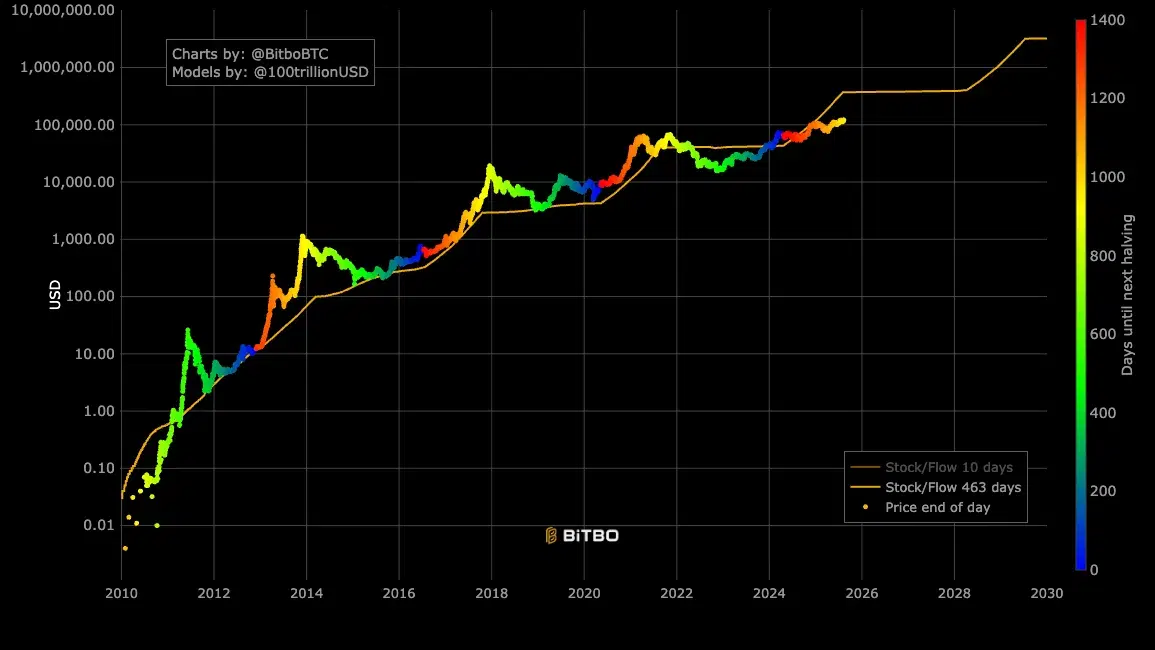Cathie Wood’s firm, ARK Invest, is known for big swings. Their latest Bitcoin call is a monster though – They see a path to $2.4 million by 2030!
This isn’t just a number pulled from thin air. It’s built on a model where Bitcoin starts eating into every major financial asset on the planet. However, with Wall Street now in the game and regulators watching closely, you have to wonder if they’re seeing the future or just dreaming.
How did they get to that bonkers number?
ARK’s math is basically a game of market share. They look at huge pots of money—like institutional assets and the entire gold market—guess how big they’ll be in 2030, and then predict how much of a slice Bitcoin will carve out for itself.
Their most optimistic scenario, laid out in reports like “Big Ideas,” imagines Bitcoin snatching 6.5% of the institutional investment pie and grabbing 60% of gold’s turf. They also bake in assumptions about its use in emerging economies and by corporate treasuries.
They even have a trick up their sleeve that sent their already-high targets into orbit. By introducing a “liveliness” metric, they just ignore about 40% of all Bitcoin, calling it “dormant” and effectively shrinking the available supply.
This single accounting move juices their bull case from an already wild $1.5 million to the new $2.4 million headline grabber.
What could power the rocket ship?
There’s a real case to be made that the rocket fuel is already in the tank, and it lines up perfectly with ARK’s thinking.
Wall Street finally showed up! – The floodgates didn’t just open in 2024 with the launch of U.S Spot Bitcoin ETFs; they were blown off their hinges. These new, easy-to-buy products saw a staggering $12.8 billion pour in during July 2025 alone. BlackRock’s IBIT fund is now a titan with over $80 billion under its belt. All this new money has convinced regulators the market is growing up, leading the SEC to greenlight more complex options trading.
It’s not just Wall Street suits, either. Public companies now sit on a hoard of over 774,000 BTC, following the lead of fanatics like MicroStrategy. Even sleepy pension funds, like Michigan’s state retirement system, are dipping a toe in, tripling their stake in one Bitcoin ETF to over $10 million.

Source: BitcoinTreasuries
Built-in scarcity engine – Bitcoin’s core appeal is its rigid, unchangeable scarcity. An event called the “halving,” which happens every four years, automatically slashes the creation of new coins in half. It’s a manufactured supply crisis that has historically kicked off massive price rallies. After the April 2024 halving, Bitcoin’s inflation rate dropped below 1%, making it look incredibly solid next to government-printed money.
This programmed scarcity is why some models, like the controversial Stock-to-Flow, have long predicted a million-dollar price tag.


Source: S2F Model, Bitbo Charts
Golden throne usurper – A huge part of this bet is that Bitcoin will eventually steal gold’s crown as the world’s go-to asset for preserving wealth. The argument is simple: Bitcoin is easier to divide, easier to move, and its scarcity is mathematically certain. As big-money players and maybe even central banks start to buy that argument, moving even a fraction of gold’s massive market value into Bitcoin could have an explosive effect. In a shaky world economy, people are already using it as an escape hatch from crashing local currencies.
What could stop the ascent?
Every bull run faces a wall of worry, and Bitcoin’s is a big one.
The regulatory hammer? – The biggest monster under the bed is regulation. Washington’s recent friendlier tone could be a feint before a knockout punch. On a global scale, watchdogs like the Financial Stability Board are busy building a regulatory cage designed to stop crypto from getting too wild.
Their rules, set to be reviewed in late 2025, could wrap the industry in so much red tape that it chokes out the very innovation that makes it exciting.
Not the only game in town – For the first time, Bitcoin has real rivals. Its singular focus on being “digital gold” makes it look one-dimensional next to competitors. Ethereum has built a sprawling digital city of decentralized finance and NFTs on its platform. Other networks, like Solana, are nipping at its heels with faster and cheaper transactions. But the biggest long-term threat might just be governments beating crypto at its own game.
As countries like China push their own Central Bank Digital Currencies (CBDCs), the average person might just prefer a state-guaranteed digital dollar or yuan, leaving Bitcoin as a strange collectible for a small group of believers.
Dirty energy debate – And, then there’s the never-ending fight over Bitcoin’s energy bill. Critics slam its massive carbon footprint, which keeps some big investors away. The industry is fighting back, claiming miners can actually help the environment by using stranded renewable energy or gas that would otherwise be flared.
Is it an environmental menace or a grid-stabilizing solution? This messy PR war isn’t going away and will continue to shape how politicians and the public see Bitcoin.
A collision course ahead?
A single Bitcoin worth seven figures isn’t just a price; it would mean a total market value that rivals the entire U.S. money supply. That kind of shift doesn’t happen without a fight. This is what the battle is about – Wall Street’s newfound hunger versus the threat of a global regulatory crackdown.
It’s the elegance of digital scarcity versus the messy politics of energy and technological competition. ARK has placed its bet on a financial revolution. The next few years will show if it was a genius call or the most expensive “what if” in history.
